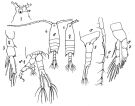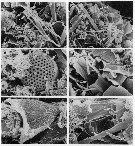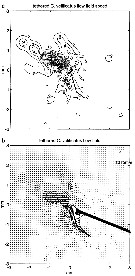|
|
 |
|
Calanoida ( Order ) |
|
|
|
Diaptomoidea ( Superfamily ) |
|
|
|
Centropagidae ( Family ) |
|
|
|
Centropages ( Genus ) |
|
|
| |
Centropages velificatus (Oliveira, 1947) (F,M) | |
| | | | | | | Syn.: | Manaia velificata Oliveira, 1946 (1947) (p.466, Descr.F, figs.F);
Centropages furcatus : Björnberg, 1963 (p.42, Rem.); ? Krumme & Liang, 2004 (p.407, tab.1);
Clausocalanus velificatus : Hopcroft & al., 1998 (tab.2, lapsus calami) | | | | Ref.: | | | Vervoort, 1964 b (p.308); 1965 (p.90, Rem.); Fleminger & Hulsemann, 1973 (p.345, figs.F,M, Rem., carte); Björnberg & al., 1981 (p.605, 644, figs.F,M); Fleminger, 1975 (p.397); Turner & Dagg, 1983 (p.16); Tester & Turner, 1988 (p.211); Grant, 1988 (p.227); Blades-Eckelbarger & Marcus, 1992 (p.41, figs. eggs); Bundy & Paffenhöfer, 1993 (p.3, figs.F); Chen & Marcus, 1997 (p.587, Rem: egg); Lopez-Salgado & Suarez-Morales, 1998 (p.318); Paffenhöfer & Loyd, 2000 (p.171, figs.F); Ferrari & Dahms, 2007 (p.63, Rem.) |  issued from : Björnberg T.K.S. in Copepoda. D. Boltovskoy, ed., Atlas del zooplancton del Atlantico sudoccidental y metodos de trabajo con zooplancton marino. 1981. [Fig. 215, p.643]. Female: 1, habitus (dorsal view); 2, head (o: eye; ventral view); 3, P5. Male: 4, habitus (dorsal view); 5, Th5 and urosome (lateral view); 6, A1 (distal segments); 7, left P5; 8, distal part of Th5, urosome and right P5 (ventral view).
|
 issued from : Fleminger A. & Hulsemann K. In: The Biology of the Indian Ocean, B. Zeitzchel Ed., 1973. [Fig. 6, p.345]. Comparison between C. furcatus and C. velificatusC. furcatus : a, Male (P5, posterior view); b, Female (fifth thoracic segment and genital segment, dorsal view); specimens from Gulf Panama (off Panama City). C. velificatus : Male (P5, posterior view); d, Female (fifth thoracic segment and genital segment, dorsal view); specimens from Gulf of Mexico (off Galveston).
| | | | | Compl. Ref.: | | | Turner, 1987 (p.377, feeding-fecal pellets); Tester & Turner, 1989 (p.231, feeding rate);1990 (p.169, egg production); Turner & Tester, 1989 (p.21, grazing); Suarez & al., 1990 (tab.2); Suarez & Gasca, 1991 (tab.2); Suarez, 1992 (App.1); Roff & al., 1995 (p.165, table 1, 3, 5, nauplii development times, nauplii copepodites growth rates, naupllii vs. bacteriophagy/picoplankton; naupliar production); Eskinazi-Sant'Anna & Tundisi, 1996 (tab.2); Paffenhöfer & al., 1996 (p.1699, motion behavior); Bundy & Paffenhöfer, 1996 (p.113, flow fields); Marcus, 1996 (p.144); Suarez-Morales & Gasca, 1997 (p.1525); Lopes & al., 1998 (p.195); Alvarez-Cadena & al., 1998 (tab.1, 2, 3, 4); Suarez-Morales & Gasca, 1998 a (p109); Mauchline, 1998 (tab.21, 22, 47, 62, 63); Lopes & al., 1999 (p.215, tab.1); Lopez-Salgado & al., 2000 (tab.1); Alvarez-Silva & Gomez-Aguirre, 2000 (p.163: tab.2); Sterza & Fernades, 2006 (p.95, Table 1, occurrence); Alcaraz & al., 2007 (p.121); Morales-Ramirez & Suarez-Morales, 2008 (p.513); Muelbert & al., 2008 (p.1662, Table 1); Miyashita & al., 2009 (p.815, Tabl.II); Medellin-Mora & Navas S., 2010 (p.265, Tab. 2); Magris & al., 2011 (p.260, abundance, interannual variability); Tutasi & al., 2011 (p.791, Table 2, 3, abundance distribution vs La Niña event, Rem. p.798); Costa R.G. da & al., 2011 (p.364, Table 1, seasonal occurrence); Almeida LR. & al., 2012 (p.13, Table 1, abundance); Miyashita & al., 2012 (p.1557, Table 2: occurrence); Araujo & al., 2016 (p.1, Table 3, abundance, %); Marques-Rojas & Zoppi de Roa, 2017 (p.495, Table 1); Dias & al., 2018 (p.1, Table 2: vertical distribution, abundance vs. season); Acha & al., 2020 (p.1, Table 3: occurrence % vs. ecoregions, Table 5: indicator ecoregions). | | | | NZ: | 3 | | |
|
Distribution map of Centropages velificatus by geographical zones
|
| | |  issued from : J.T. Turner in Biol. Bull., 1987, 133. [p.384, Fig.6] issued from : J.T. Turner in Biol. Bull., 1987, 133. [p.384, Fig.6]
Contents of Centropages velificatus fecal pellets from 28°48' N, 89°58' W (30 November 1983-.
a: Skeletonema costatum fragments (arrows); b: Skeletonema costatum (S) and Thalassiosira sp. (T) fragments; c: intact centric diatom cell (arrow); d: Thalassiothrix sp. fragments (arrow); e: fragment of an unidentified dinoflagellate (arrow); f: crustacean remains (arrows). |
 issued from : M.H. Bundy & C.-A. Paffenhöfer in Mar. Ecol. Progr. Ser., 1996, 133. [p.103, Fig.2]. issued from : M.H. Bundy & C.-A. Paffenhöfer in Mar. Ecol. Progr. Ser., 1996, 133. [p.103, Fig.2].
Feeding current of a tethered female Centropages velificatus (cephalothorax length = 1.2 mm), collected off the coast of Georgia (USA), feed with Gymnodinium nelsoni and Thalassiosira eccentrica. After acclimatation, the copepods were placed in complete darkness prior to videotaping in a 6 l cubic vessel, in the dark.
a: Flow field velocity. Contours represent fluid speeds and are plotted at 1 mm/sec intervals.
b: Flow field geometry. Vectors indicate direction and magnitude of flow. |
 Issued from : J.C. Roff, J.T. Turner, M.K. Webber & R.R. Hopcroft in Aquat. microb. Ecol., 1995, 9. [p.170, Table 5]. Issued from : J.C. Roff, J.T. Turner, M.K. Webber & R.R. Hopcroft in Aquat. microb. Ecol., 1995, 9. [p.170, Table 5].
Summary observations on naupliar bacterivory on FLB (fluorescently labelled bacteria) a partir Escherichia coli (±0.7 µm3 cell volume) in Kingston Harbour and Lime Cay (Jamaica).
Fluorescence levels: 0 = no materal for observation; - = no fluorescence observed; + = low fluorescence due to few FLB observe; * = highly fluorescence due to many FLB.
The authors show of the 11 species examined (Centropages velificatus, Acartia lilljeborgi, Paracalanus aculeatus, Temora stylifera, Undinula vulgarius, Euchaeta marina, Clausocalanus spp., Onaea sppp., Corycaeus spp.), 7 showed clear evidence of feeding on FLB (see table 5), with 92% of their nauplii ingesting FLB, clearly visible in the guts of many nauplii, and usually comprisised a discrete feeding (foregut) or 'fecal' (hindgut) bolus of cells. After only 30 min, fecal pellets were being produced already filled with FLB. Presence of FLB in guts cannot be interpreted as incidental feeding or 'drinking', because 4 species failed to ingest them (Centropages velificatus, Euchaeta marina, Clausocalanus sp., Corycaeus sp.). The very earliest stages may not ingest bacteria or other particles because they may have yolk reserves (for example Temora turbinata N1 nauplii did not ingest FLB, but later stage nauplii did). |
| | | | Loc: | | | Uruguay (continental shelf), Brazil (Paranagua Bay, Rio de Janeiro, Campos Basin, Vitoria Bay, Mucuri estuary, Guarairas Lagoon, estuario do Pina, ? Bragança: Caeté Bay, Ajuruteua Bay), Caribbean Colombia, Bahia de Mochima (Venezuela), Yucatan, Caribbean, Jamaica (Kingston Harbour, Lime cay), E Costa Rica, G. of Mexico, Turkey Point, Mississipi (off Southwest Pass), Florida, Georgia, Delaware Bay, Long Island, Galapagos-Ecuador in Tutasi & al. (2011) | | | | N: | 37 (SW Atlant. 11; NW Atlant.: 20, E Pacif: 1) | | | | Lg.: | | | (202) F: 1,75-1,6; M: 1,9-1,5; (237) F: 1,9; M: 1,6-1,75; {F: 1,6-1,90; M: 1,5-1,9} | | | | Rem.: | Distinct species or Atlantic variety of Centropages furcatus . See rem. for Centropages furcatus velificatus.
The species reported by Krumme & Liang ( 2004) belongs no doubt to this form.
After Tutasi & al. (2011, p.798, Table 2, 3) indicate this species in the Eastern equatorial Pacific, with maxima in the central area of the Pacific Equatorial Front (probably for the first time); the species had a wide distribution and maxima at the stations in the central area (Galapagos-Ecuador) of the equatorial Front. | | | Last update : 17/10/2020 | |
|
|
 Any use of this site for a publication will be mentioned with the following reference : Any use of this site for a publication will be mentioned with the following reference :
Razouls C., Desreumaux N., Kouwenberg J. and de Bovée F., 2005-2025. - Biodiversity of Marine Planktonic Copepods (morphology, geographical distribution and biological data). Sorbonne University, CNRS. Available at http://copepodes.obs-banyuls.fr/en [Accessed November 17, 2025] © copyright 2005-2025 Sorbonne University, CNRS
|
|
 |
 |







